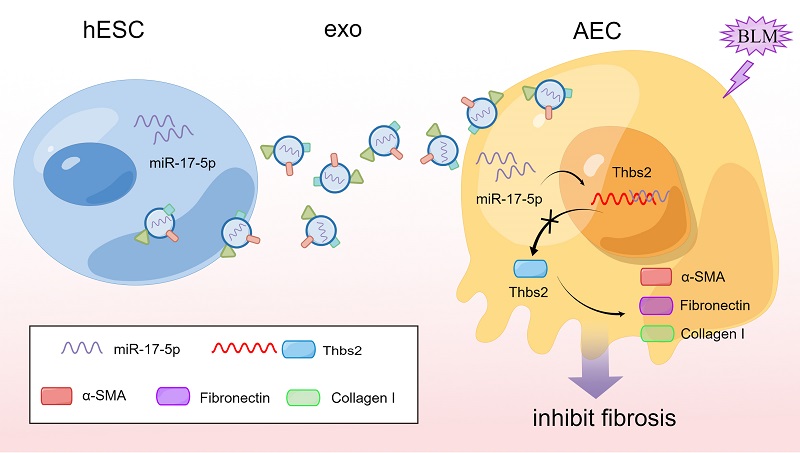JI Guangju Lab reports the role and mechanism of human embryonic stem cell exosomes in the treatment of pulmonary fibrosis
Idiopathic pulmonary fibrosis (IPF) is a chronic, progressive, irreversible lung disease characterized by pulmonary fibrosis and impaired lung function, eventually leading to respiratory failure. Many studies have found that multiple stem cell-derived exosomes have great potential in anti-fibrosis. Among them, mesenchymal stem cell-derived exosomes (MSC-Exos) have been paid more attention, due to excellent immune regulation and regenerative repair relying on their bioactive. Our previous study found that human embryonic stem cell-derived (hESC-Exos) was prior to modulating injury repair compared to MSC-Exos. Moreover, there is no investigation reported regarding the therapeutic effects of hESC-Exos on IPF.
On September 4, 2023, Stem Cell Research & Therapy published Ji's work, entitled "Exosomal miR-17-5p from human embryonic stem cells prevents pulmonary fibrosis by targeting thrombospondin-2". The study initially describes the noteworthy effect of hESC-Exos on the intervening of IPF and the underlying mechanism. The hESC-Exos holds a novel perspective for developing anti-fibrosis drugs attributed to reducing inflammation, clearing collagen deposition, remodeling alveolar architecture, and improving pulmonary blood flow followed by increases in the faction of the lung.

Fig. 1 hESC-Exos remodels fibrotic lung architecture and improves lung function.
Furthermore, the enriched miR-17-5p in hESC-Exos functionally binds to the 3'UTR of Thrombospondin-2 (Thbs2), a known fibrosis-related gene, resulting in the alleviation of pulmonary fibrosis.

Fig. 2 The hESC-Exos alleviated pulmonary fibrosis by reducing Thbs2 expression via delivering miR-17-5p into BLM-induced Idiopathic pulmonary fibrosis.
This study, for the first time, reveals the significant role of hESC-Exos in mitigating pulmonary fibrosis, showcasing impressive immunomodulatory and tissue repair properties. Moreover, it highlights the extensive potential of hESC-Exos for addressing fibrotic diseases.
The corresponding authors are Dr. JI Guangju and Dr. WANG Huiwen. LIU Qun and BI Youkun are the first and co-first authors, respectively.
Article link: https://stemcellres.biomedcentral.com/articles/10.1186/s13287-023-03449-7
Contact: WU Yanyun
Institute of Biophysics, Chinese Academy of Sciences
Beijing 100101, China
Email: wuyanyun109@126.com
(Reported by Prof. JI Guangju's group)

